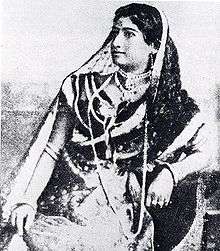Binodini Dasi
| Binodini Dasi | |
|---|---|
 | |
| Born | 1862 |
| Died | 1941 (aged 78–79) |
| Other names | Notee Binodini |
| Occupation | Drama actress |
Binodini Dasi (1862–1941), also known as Notee Binodini, was a Calcutta-based, Bengali-speaking renowned actress and thespian.[1] She started acting at the age of 12 and ended by the time she was 23, as she later recounted in her noted autobiography, Amar Katha (The Story of My Life) published in 1913.[2]
Biography
Born to prostitution, she started her career as a courtesan and at twelve she played her first serious drama role in Calcutta's National Theatre in 1874, under the mentorship of its founder, Girish Chandra Ghosh.[3] Her career coincided with the growth of the proscenium-inspired form of European theatre among the Bengali theatergoing audience. During a career spanning twelve years she enacted over eighty roles, which included those of Pramila, Sita, Draupadi, Radha, Ayesha, Kaikeyi, Motibibi, and Kapalkundala, among others. She was one of the first South Asian actresses of the theatre to write her own autobiography. Her sudden retirement from the stage is insufficiently explained.
Sri Ramakrishna, a saint of 19th century Bengal, came to see her play in 1884.[4] During her bygone days of glory, she was referred to as the Flower of the Native Stage and Moon of the Star Theatre. She was a pioneering entrepreneur of the Bengali stage and introduced modern techniques of stage make-up through blending European and indigenous styles.
Veteran Bengali actor Soumitra Chatterjee who has written the introduction to the recent reprint of her autobiography, mentions that the chroniclers of the theatre movement in 19th century Bengal make no reference to Binodini. This may be partly explained as an instance of class-caste divide. The upper class Brahmin-Brahmo dominated establishment that spearheaded the Bengal Renaissance felt it improper to acknowledge the merits of the talented lowly born. Her contribution to the establishment and enrichment of the organisations she was associated with, has been largely glossed over.
Her autobiography is lucid and explores a section of the 19th century Bengali world, at ease with European ideas, but conscious enough to carefully subjugate the female to the domain of the household. Women who talked of and expressed in their lives the very embodiment of liberated femininity were, surreptitiously viewed from a distance, to be loved and be the object of scorn—and never aspire to respectable notions of femininity.
In popular culture
- Nati Binodini, a 1994 Bengali film starring Prasenjit Chatterjee and Debashree Roy.[5]
- Nati Binodini, a play based on her autobiography, "Aamar Kathaa" was first presented by National School of Drama Repertory Company in 1995 with the lead role done by actor, Seema Biswas, then in 2006, noted theatre director Amal Allana directed a play by the same name which premiered in Delhi.[6][7][8]
- In Abohoman, the 2009 Bengali film by Rituparno Ghosh, the lead character is a filmmaker who makes a film based on the lives of Binodini Dasi and Girish Chandra Ghosh. Several scenes from this film-within-the-film are shown.
References
Citation
- ↑ Murshid, Ghulam (2012). "Dasi, Binodini". In Islam, Sirajul; Jamal, Ahmed A. Banglapedia: National Encyclopedia of Bangladesh (Second ed.). Asiatic Society of Bangladesh.
- ↑ "Women on stage still suffer bias: Amal Allana (Interview)". Sify News. 11 March 2010. Retrieved 2 April 2010.
- ↑ Bringing alive Binodini Dasi The Tribune, Sunday, 18 November 2007.
- ↑ Christopher Pinney, Photos of the Gods p. 42
- ↑ Nati Binodini-IMDB
- ↑ Romesh Chander (8 December 2006). "Autobiography comes alive : "Nati Binodini", based on Binodini's autobiography "Aamar Kathaa"". The Hindu. Retrieved 2 April 2010.
- ↑ "STAGE CRAFT". India Today. 8 February 2008. Retrieved 2 April 2010.
- ↑ "Lights, sets, action..: Nissar and Amal Allana's "Nati Binodini" premieres this weekend in Delhi.". The Hindu. 24 November 2006. Retrieved 2 April 2010.
Sources
- DeLamotte, Eugenia C.; Natania Meeker; Jean F. O'Barr (1997). "Binodini Dasi". Women imagine change. Routledge. ISBN 978-0-415-91531-1.
- Tharu, Susie J.; Ke Lalita (1991). "Binodini Dasi". Women Writing in India: 600 B.C. to the early twentieth century. Feminist Press. ISBN 978-1-55861-027-9.
- Trivedi, Poonam; Dennis Bartholomeusz (2005). India's Shakespeare. University of Delaware Press. ISBN 978-0-87413-881-8.
- Feldman, Martha; Bonnie Gordon (2006). The courtesan's arts. Oxford University Press US. ISBN 978-0-19-517029-0.
- Forbes, Geraldine Hancock; Gordon Johnson (1999). Women in modern India. Cambridge University Press. ISBN 978-0-521-65377-0.
Further reading
- Binodini Dasi: My Story and My Life as an Actress. Edited and translated by Rimli Bhattacharya. New Delhi: Kali for Women, 1998.
External links
| Wikimedia Commons has media related to Binodini Dasi. |